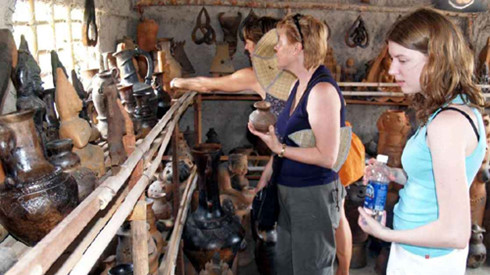Improving position of Bau Truc pottery brand in Vietnamese tourism
 |
Kneaded by hand, Bau Truc ceramic products are standalone items demonstrating the talent and unique craftwork of the artisans in the village.
Preserving traditional pottery
According to current statistics, Bau Truc Pottery Village has 570 households with 4,034 people, including 100 households producing pottery.
Ceramic products produced by artisans in the village are divided into two types, viz. domestic-use pottery and arts and handicraft pottery.
Domestic-use pottery, such as jars, ovens and pots, mainly serve residents of rural areas and are consumed in the provinces in the south-central region and Ho Chi Minh City.
Meanwhile, with diverse designs and patterns, craft pottery products, including flower vases, pitchers, lamps, decorative lights and statues imbued with Cham culture, have been popular not only domestically, but also on the international market.
The pottery industry in Bau Truc Village began a long time ago and is famous for employing strictly manual labour.
Bau Truc artisans make use of the shaping “style” of Cham folk arts, using simple tools such as bamboo sticks, arca and snail shells to engrave different patterns, including symmetrical geometric figures, rivers and plants, into their pottery.
Two important factors demonstrating the uniqueness of Bau Truc pottery are raw materials and skilled potters. The clay used to make Bau Truc pottery products is taken from the waterfront of the Quao River.
The potters smash the clay into pieces and mixe them with fine sand and knead the mixture. The amount of mixed sand depends on the size and uses of each product.
The artisans do not use spinning wheels to shape their products. They move their hands around the clay to create different shapes and patterns. After finishing an item, the products are exposed to the sun until they are dry and are then polished and burned.
Pottery products in Bau Truc Village are not baked in kilns. Artisans cover them with straw and firewood to bake them. With their skilful colouring and baking techniques, the potters give their products unique colours, resulting in the typical traditional style of the village.
Artisan Truong Thi Gach, 78 years old, said, “I started learning to make pottery when I was eight years old and my life wad devoted to this trade. There are few people having passion for pottery; therefore, I will make a greater effort to train younger generations in order to preserve the Cham culture’.
Developing the Bau Truc pottery brand in association with tourism
Phu Huu Minh Thuan, Head of Bau Truc Pottery Village Co-operative said that each year there were over 6,000 visitors to the village—70% domestic and 30% foreign tourists, mainly from Russia, Japan, Germany and Australia.
“The village has focused on developing handicraft pottery products to meet the aesthetic needs of visitors as well as preserving unique identities of Cham culture,” Thuan shared.
Currently, the pottery cooperative displays more than 1,000 products of different types; many of them have sophisticated patterns, becoming favourites of a large number of customers, both domestic and foreign.
At prices ranging from VND15,000 to VND3 million per product, the Bau Truc cooperative have sold around 35,000-40,000 pieces of pottery each year, earning a total turnover of over VND800 million.
In order to preserve and develop Bau Truc pottery, the Ninh Thuan People’s Committee implemented a “marketing strategy project for Bau Truc handicraft pottery for the 2010-2015 period, with a vision to 2020” with a total investment of VND26.3 billion.
In recent years, the province has paid much attention to supporting artisans in train younger generations and building a specific exhibition area for displaying and introducing Bau Truc pottery.
In addition, the authorities enhanced communication on mass media to widely promote the products and marketed them at trade fairs and events on souvenir pottery products as well as providing capital support for households in the village to enhance their production and business activities and to expand their domestic and export markets.
Thuan also shared that the co-operative was building a project to export a large shipment of Bau Truc pottery to the UK late this year. The event is a good sign for the development of the Bau Truc pottery brand.
The relevant agencies are submitting a dossier with the aim of having Bau Truc pottery recognised as a part of the nation’s intangible cultural heritage. The Ministry of Culture, Sports and Tourism will soon prepare the dossier for submission to UNESCO for recognition as Intangible Cultural Heritage in Need of Urgent Safeguarding.
What the stars mean:
★ Poor ★ ★ Promising ★★★ Good ★★★★ Very good ★★★★★ Exceptional
Latest News
More News
- The destinations powering Vietnam’s festive season travel demand (December 04, 2025 | 18:33)
- Vietnam named among the world’s most exciting winter destinations (December 04, 2025 | 15:10)
- Phu Tho emerges as northern Vietnam’s new tourism hub (December 01, 2025 | 17:00)
- Vietjet completes Airbus A320/A321 updates ahead of deadline (December 01, 2025 | 09:49)
- Vietjet resumes Con Dao flights from early December (November 28, 2025 | 15:24)
- Free tickets, Lunar New Year promotions on offer at Vietjet Mega Livestream (November 26, 2025 | 15:32)
- Scandinavian Airlines and Vietnam Airlines broaden agreement with new routes (November 25, 2025 | 17:04)
- Halong Cruise Port welcomes over 3,100 international visitors (November 12, 2025 | 18:06)
- Vietnam.travel climbs to second place in Southeast Asia website rankings (November 12, 2025 | 18:01)
- Cat Ba named among Southeast Asia’s top island adventures (November 11, 2025 | 18:09)

















 Mobile Version
Mobile Version